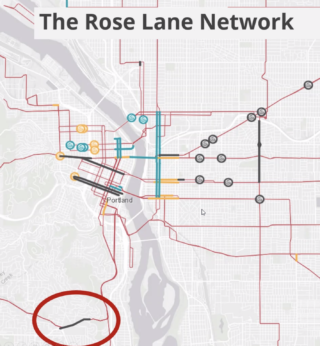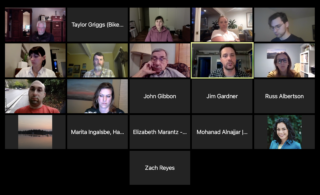Cycling News & Blog Articles
New bus lane planned for SW Capitol Highway as part of ‘Rose Lane’ network

Existing and future conditions at SW Capitol Highway and Sunset.
“This is an opportunity to help set a new normal, to minimize impacts as travel activity increases in our communities.”
— PBOT
The Portland Bureau of Transportation intends to give Southwest Capitol Highway through the Hillsdale commercial district a makeover to make room for better bus service. The plan is to reduce space for car users and create a bus-and-turn (BAT) only lane on Capitol Highway for a one-mile stretch between Barbur Boulevard to Bertha Court.
The project is part of PBOT’s Rose Lane plan, intended to give buses priority in congested areas to make transit faster and more reliable. Rose Lanes launched in November 2019 under former PBOT Commissioner Chloe Eudaly with the expressed intention of using transportation projects to tackle racial disparities and climate change.
PBOT says the Capitol Highway project, one of 25 projects in the Rose Lane Priority Transit Network announced in December 2020, is an opportunity to seize space for non-drivers on this key corridor, while some local interests worry about spillover impacts.
Advertisement
At a meeting of the Southwest Land Use & Transportation Forum Tuesday, PBOT Senior Transportation Planner Nick Falbo said, “It’s hard to overstate how important transit is on the SW Capital Highway corridor. We’re really excited that this project can help set a foundation for keeping efficient bus travel now and into the future.” In a presentation, Falbo said inconveniences for auto users have been minimized and no auto parking removal is in the plans. People driving will be able to use the bus lane to make right turns or pull into driveways.
The biggest change will be at the intersection of SW Capitol Highway and SW Sunset Boulevard, where PBOT will implement BAT lanes in both direction leading up to Sunset. Planning documents illustrate an eastbound BAT lane from Bertha to Sunset, and a westbound lane from Sunset to Barbur.
Based on 2019 ridership data, PBOT estimates 11,730 riders will benefit from this Rose Lane project. However, estimating the significance a project will have in 2022 based on 2019 figures is like comparing apples to oranges. The pandemic severely impacted TriMet ridership, and although ridership has been improving slowly, it was still down about a million estimated weekly boardings in February of this year compared to February 2020.
Despite gains for transit users, not everyone is eager for changes to Hilldale’s main street. The Hillsdale Business and Professional Association (HBPA) says they support the project’s goals, but has concerns and shared list of several questions in a letter to PBOT.
The letter says community concerns are about the proposed westbound route and how it will impact “livability for our residents, the greenhouse gas impact, the safety of our pedestrians, and bicycle users on the affected streets [and] the economic impact on our struggling businesses and especially our growing percentage of vulnerable seniors.”
The HBPA also asks PBOT to consider focusing on what they say the commercial and residential communities of Hillsdale really need: safe sidewalks or walking space between SW Cheltenham and Terwilliger.
Advertisement
(Slides shown at neighborhood meeting Tuesday.)
“Devoting resources to create this much-needed pedestrian connection is the most effective safety improvement Portland can make to this congested corridor,” the letter reads.
SW Capitol Highway is designated as a high crash corridor by PBOT. Improving safety for people walking and biking on the street has been a stated priority by the transportation bureau for some time, and the Southwest in Motion (SWIM) plan to improve active transportation in SW Portland has multiple suggested improvements for this corridor.
Falbo said building the Rose Lane, which has a budget of $200,000, won’t stand in the way of progress on pedestrian and bike safety projects.
“We could only build about 100 feet of sidewalk for what it costs to build this Rose Lane,” he said.
Falbo also clarified that this project won’t impede the existing bike lane on Capitol Hwy. In fact, he says people riding bikes will benefit from riding adjacent to a BAT lane, because buses don’t travel as fast as the rest of motor vehicle traffic does, not to mention the people driving buses are professional drivers trained to watch out for people biking.
Community members are also concerned that reducing car capacity by turning outer lanes into adding bus-and-turn lanes will cause congestion, encouraging people driving to divert onto side streets. Falbo countered that the Rose Lane will have minimal traffic impact because there aren’t as many cars on the road. Traffic volume on SW Capitol Highway has been down 50 to 80 percent in 2021 compared to pre-pandemic levels.
“If auto traffic increases in the coming years, people driving may experience an additional 20 to 90 seconds of delay — less than half the length of a typical song on the radio,” PBOT’s project description says.
The HBPA said PBOT is exaggerating the benefits it says this Rose Lane will have for bus passengers.
“Our initial current investigations suggest the passenger time savings being claimed for this improvement are seriously overstated,” their letter states.
“If auto traffic increases in the coming years, people driving may experience an additional 20 to 90 seconds of delay — less than half the length of a typical song on the radio.”
— Nick Falbo, PBOT
But PBOT maintains the Rose Lane will expedite bus travel for passengers. According to PBOT planners, this project will allow someone departing from Capitol Highway and SW 35th at 7:30 a.m. to be able to reach 5% more jobs within 45 minutes thanks to expanded access into NE, SE and SW Portland.
It’s worth noting PBOT is using pre-pandemic numbers to calculate the positive impacts this project will have, while figuring the traffic delays using the reduced current numbers. But Falbo said he sees this as a time to encourage people to change their transportation habits. If people experience benefits from taking the bus now, maybe pre-pandemic traffic will never recover, because more people will be riding transit.
A slide from the project presentation underlines this:
“Travel activity will increase over time. Our choices today inform how it comes back. This is an opportunity to help set a new normal, to minimize impacts as travel activity increases in our communities.”
There will be three more virtual organization meetings for community members to participate in throughout the next month. Construction is planned to begin this summer. You can find out more information about how to engage and the project in general here.
Taylor has been a BikePortland’s staff writer since November 2021. She has also written for Street Roots and Eugene Weekly. Contact her at This email address is being protected from spambots. You need JavaScript enabled to view it.



